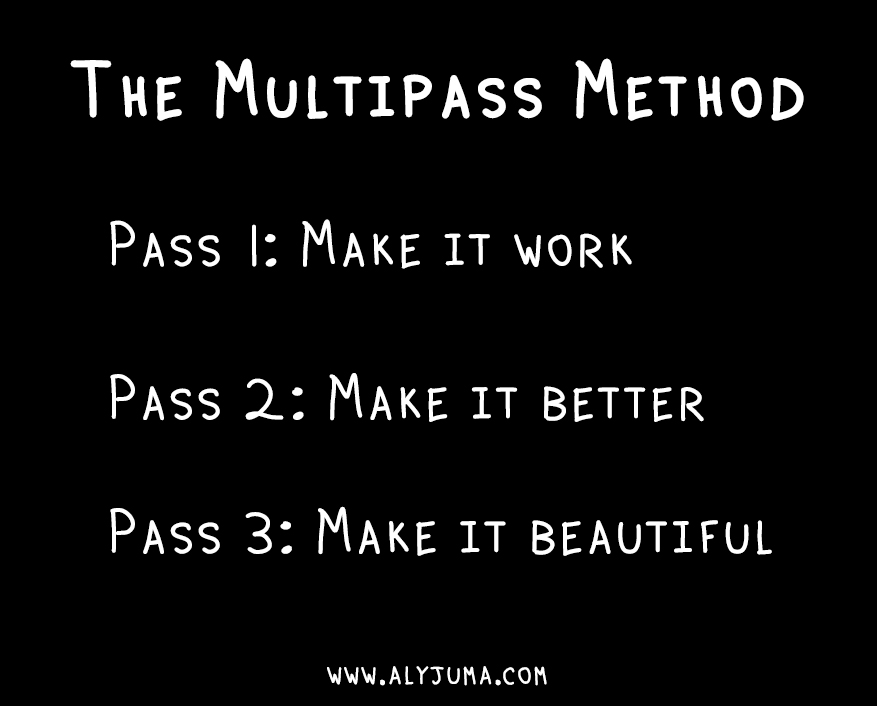I have a problem. I love making new things, but I always want them to be perfect.
In my mind, I envision getting every piece of every project just right. The elegant piece of code. The flawless piece of writing. The seamless product design.
When I approach things this way, something else happens: I hit an imaginary wall. What I’ve conjured up in mind is perfect, but executing it is another matter entirely.
How am I going to achieve this level of quality from the outset? Where do I even begin? And so begins the process of making the perfect larger than life, which in turn makes my ability to achieve it ever more unlikely.
Does this ever happen to you? Where the idea of perfection isn’t so much a goal, but an anchor, preventing you from making any real progress. Instead of just creating, I overthink things and try to improve and edit my work as I produce it. This is a long and inefficient process. Far too often, I feel like I’m going in circles.
Perfection is a worthy aspiration, to be sure, but it’s also an easy way to stop you dead in your tracks. Perfection hardly materializes out of thin air. It takes a lot of time and effort. So how do you strive for perfection without it being a roadblock?
I decided to re-frame my work, so that it was more a gradual effort towards perfection, rather than an immediate one. This is where the Multipass Method comes into play.
Rather than seek perfection from the get go, which let’s face it is nearly impossible, I break things down into three separate passes: make it work, make it better, and make it beautiful.  Let’s take a closer look at the three passes and what each one means.
Let’s take a closer look at the three passes and what each one means.
Pass 1: Make it work
It all starts with making it work. Whatever it is, you need to build a foundation, which often means just making the thing. No matter how bad or inefficient or ugly it turns out, it’s important to just get it all down to give you something to begin with.
The beauty of the first pass is that you should have ridiculously low expectations for the quality of your work. This is the opposite of perfection. It’s just a way to get the ball rolling.
By giving yourself a pass on quality, you’re able to do exactly that.
Pass 2: Make it better
Now that you have something to work with, you can start to improve on the work. The second pass is all about applying what you learned the first time around.
I’m sure we’ve all gone through the feeling of seeing where things can be better, even as we do them. Now that you have the entire piece of work done, its far easier to see the bigger picture and improve it.
After all, what you thought you were going to do and what you end up doing can often be very different things. The second pass is the time to take what you actually have and tie it all together. To take the disparate pieces of your work and make them a cohesive whole.
Pass 3: Make it beautiful
The final pass is about incremental improvement. This is where we strive for beautiful, or in other words, perfection. Now you can find the right words, balance the layout, smooth the lines, make the code sing, and so on.
Pass three is what takes your work from pretty good to pretty perfect. The best part is that this struggle for perfection comes towards the end of the process. You’re not banging your head against the wall before you can see the forest for the trees.
On the contrary, the picture is already pretty clear and you can take the time to improve it as you see fit.

The Multipass Method is a lot like an iterative approach, except that each iteration is focused on a specific outcome.
Every pass brings you closer to perfection, but doesn’t get in your way either. This is essential for those of us that can get distracted by getting things right the first time.
Have no fear of perfection, you’ll never reach it.Salvador Dali
Despite this method being all about perfection, its important to realize that perfection is never really attainable, though still something worth striving for.
There comes a point where your work is done and it is perfect for your needs. You don’t want to get stuck spinning your wheels on tiny details that aren’t truly going to move the needle.
This method is more about getting out of your own way and creating without the burden of perfection weighing you down. You can always make things better, but that should come towards the end of the process.
In the words of Vince Lombardi, “Perfection is not attainable, but if we chase perfection, we can catch excellence.”
I find that the Multipass Method allows me to chase perfection, without getting paralyzed by it. Hopefully it does the same for you.
Keep on chasing.
Image via flickr

